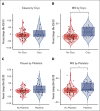Trauma-induced dysfibrinogenemia: the von Clauss assay does not accurately measure fibrinogen levels after injury
- PMID: 40766812
- PMCID: PMC12320451
- DOI: 10.1016/j.bvth.2024.100017
Trauma-induced dysfibrinogenemia: the von Clauss assay does not accurately measure fibrinogen levels after injury
Abstract
Trauma patients who sustain severe tissue injury and hemorrhage often receive fibrinogen repletion to avert coagulopathy and achieve hemostasis. However, fibrinogen supplementation has not shown a benefit in trauma patients with coagulopathy. The von Clauss functional fibrinogen assay is the primary indication for fibrinogen transfusion. This assay, however, infers fibrinogen levels optically via in vitro clot formation time and does not directly measure the quantity or quality of plasma fibrinogen. We hypothesized that the Clauss fibrinogen activity assay does not accurately reflect true fibrinogen levels in severely injured patients. Here, we demonstrate normal baseline plasma fibrinogen levels as measured by mass spectrometry despite coagulopathic Clauss values in severely injured patients. This discrepancy is most significant in patients with coagulopathy (international normalized ratio of >1.3) or with high shock, and persists even after fibrinogen repletion. These data highlight the need to reevaluate clinical testing of fibrinogen activity and transfusion criteria for the critically injured, and indicate that correcting shock and the oxidative, inflammatory milieu of trauma may be more effective at improving fibrinogen activity. This trial was registered at www.ClinicalTrials.gov as #NCT01838863.
© 2024 by The American Society of Hematology. Licensed under Creative Commons Attribution-NonCommercial-NoDerivatives 4.0 International (CC BY-NC-ND 4.0), permitting only noncommercial, nonderivative use with attribution. All other rights reserved.
Conflict of interest statement
Conflict-of-interest disclosure: A.D. and K.C.H. are founders of Omix Technologies Inc. A.D. is a scientific advisory board member for Hemanext Inc and Macopharma Inc. The remaining authors declare no competing financial interests.
Figures





References
-
- Meizoso JP, Moore EE, Pieracci FM, et al. Role of fibrinogen in trauma-induced coagulopathy. J Am Coll Surg. 2022;234(4):465–473. - PubMed
-
- Rourke C, Curry N, Khan S, et al. Fibrinogen levels during trauma hemorrhage, response to replacement therapy, and association with patient outcomes. J Thromb Haemost. 2012;10(7):1342–1351. - PubMed
-
- McQuilten ZK, Wood EM, Bailey M, Cameron PA, Cooper DJ. Fibrinogen is an independent predictor of mortality in major trauma patients: a five-year statewide cohort study. Injury. 2017;48(5):1074–1081. - PubMed
Associated data
LinkOut - more resources
Full Text Sources
Medical
